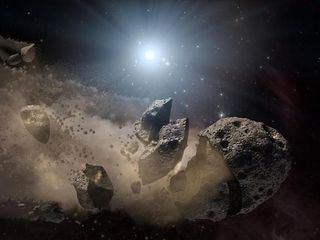Origin of Dinosaur-Killing Asteroid Is Still a Mystery

The source of the asteroid that killed off the dinosaurs 65 million years ago remains a mystery, a new study finds.
Some researchers had thought the deadly asteroid was a piece of a larger space rock called Baptistina. Baptistina broke apart after a massive in-space collision about 160 million years ago, the theory went, spawning a swarm of mountain-size chunks of rock. One of those eventually slammed into Earth, killing off the dinosaurs and many other species.
Scientists are confident that a 6-mile-wide (10-kilometer asteroid) is indeed what wiped out the dinosaurs. But new observations from NASA's Wide-field Infrared Survey Explorer (WISE) space telescope suggest the space rock didn't come from Baptistina.
The timing just isn't right, according to the new study.
"As a result of the WISE science team's investigation, the demise of the dinosaurs remains in the cold case files," said Lindley Johnson, program executive for the Near Earth Object Observation Program at NASA headquarters in Washington, in a statement. [Photos: Asteroids in Deep Space]
Questioning the theory
Baptistina first came under suspicion in some astronomers' minds after a 2007 study. In that work, researchers used visible-light data from ground-based telescopes to estimate the size and reflectivity of the Baptistina "family" — the pieces of the broken-apart space rock.
Sign up for the Live Science daily newsletter now
Get the world’s most fascinating discoveries delivered straight to your inbox.
With these estimates in hand, researchers determined that the big space rock likely broke apart about 160 million years ago. That would have given plenty of time for the Baptistina family asteroids to disperse to different and potentially dangerous orbits by the time of the dino-killing impact.
Since that study, however, various researchers have gathered more information that cast doubt on the Baptistina asteroids as suspects. And the new study may finally rule the family out altogether, researchers said.

Looking in the infrared
WISE surveyed the entire sky twice in infrared light from January 2010 to February 2011. The telescope catalogued more than 157,000 asteroids in the main belt between Mars and Jupiter and discovered more than 33,000 space rocks.
WISE also measured the size and reflectivity of 1,056 members of the Baptistina family. And these measurements were more accurate than previous efforts, leading in turn to more accurate estimates of the asteroid family's age, researchers said.
The new observations suggest that Baptistina broke apart just 80 million years ago, not 160 million years ago as some scientists had thought.
"This doesn't give the remnants from the collision very much time to move into a resonance spot, and get flung down to Earth 65 million years ago," said study co-author Amy Mainzer, of NASA's Jet Propulsion Laboratory (JPL) in Pasadena, Calif. "This process is thought to normally take many tens of millions of years."
Resonance spots are areas in the main asteroid belt where gravity nudges from Jupiter and Saturn can fling asteroids out of the belt and on a collision course with Earth. [Our Solar System: A Photo Tour of the Planets]
Though WISE wrapped up its operational life in February 2011, researchers will continue to use its observations to map out the solar system's space rocks. They want to get a better handle on where asteroids came from — and where they may be heading.
"We are working on creating an asteroid family tree of sorts," said study lead author Joseph Masiero of JPL. "We are starting to refine our picture of how the asteroids in the main belt smashed together and mixed up."
This story was provided by SPACE.com, sister site to Live Science. Follow SPACE.com for the latest in space science and exploration news on Twitter @Spacedotcom and on Facebook.













